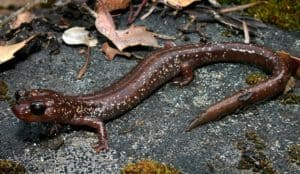
The Center for Biological Diversity has notified the U. S. Fish and Wildlife Service of its intent to sue for failure to respond to its petition to list the Siskiyou Mountains salamander as a threatened or endangered species. The species is found primarily on BLM lands, but also on the Rogue River-Siskiyou and Klamath National Forests. Prior listings were avoided largely because of provisions in the Northwest Forest Plan to protect the species:
Conservation groups first petitioned for protection of the salamander under the Endangered Species Act in 2004. To prevent the species’ listing, the Bureau of Land Management (“BLM”) and U.S. Fish and Wildlife Service signed a conservation agreement in 2007, intended to protect habitat for 110 high-priority salamander sites on federal lands in the Applegate River watershed. In 2008 the Fish and Wildlife Service denied protection for the salamander based on this conservation agreement and old-growth forest protections provided by the Northwest Forest Plan.
Here’s what’s changed (from the 2018 listing petition):
The Western Oregon Plan Revision (WOPR) which replaces the Northwest Forest Plan, has the express purpose of substantially increasing logging on BLM lands with the range of the salamander and elsewhere (USBLM 2016, p. 20). The WOPR was originally proposed in 2008 and abandoned by the BLM in 2012 after years of litigation. In August 2016 the BLM issued a final Environmental Impact Statement implementing the WOPR (USBLM 2016).
The WOPR presents a substantial new threat to Siskiyou Mountains salamanders in Oregon because it will allow increased timber harvest in late-successional areas, decrease optimal salamander habitat, increase habitat fragmentation, eliminate requirements to conduct predisturbance surveys in salamander habitat, and allow logging of previously identified known, occupied salamander sites. The WOPR removes protections for salamander populations formerly included in species protection buffers on BLM lands. Although some of the reserves on BLM lands have been enlarged in the WOPR, timber harvest emphasis areas will often be subject to more intensive logging, and logging of known, occupied Siskiyou Mountains salamander sites is allowed.
This demonstrates again the value of including regulatory mechanisms as protective measures in forest plans: they can keep species from being listed under ESA. There is already a pending lawsuit against the new WOPR (now officially called the Resource Management Plans for Western Oregon), and the Forest Service should keep this in mind when it revises its forest plans that are now governed by the Northwest Forest Plan (especially the “survey and manage” requirement).
The trend seems to be in the other direction, however (see also greater sage grouse). And when a species is listed, regulatory mechanisms are needed in forest plans to contribute to their recovery and delisting. Yet the Forest Service is removing such mechanisms from forest plans for grizzly bears, lynx and bull trout (Flathead National Forest), Indiana bats (Daniel Boone National Forest: to “provide flexibility to implement forest management activities”), and black-footed ferrets (Thunder Basin National Grassland: “greater emphasis on control and active management of prairie dog colonies to address significant concerns related to health, safety, and economic impacts on neighboring landowners”). Since plant and animal diversity was one of the main reasons for NFMA it shouldn’t be a big surprise to see these kinds of retrograde actions ending up in court.